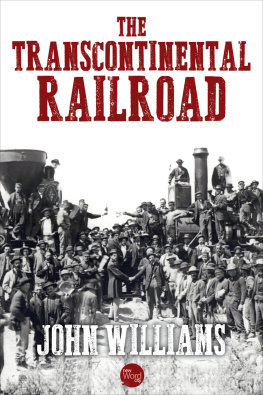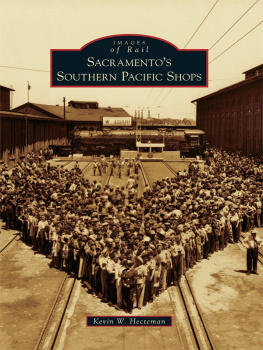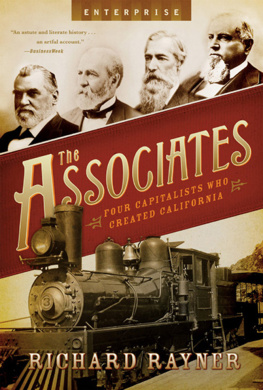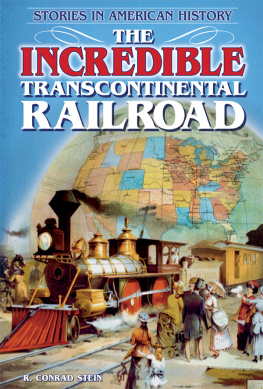
The First Transcontinental Railroad
A History of the Building of the PacificRailroad
By James K. Wheaton
By BookCaps Study Guides
2011 by Golgotha Press, Inc.
Published at SmashWords
www.bookcaps.com
Introduction
The First Transcontinental Railroad,originally called the Pacific Railroad, was a railroad built in theUnited States between 1863 and 1869 that connected the western partof America with its eastern part. Built by the Central PacificRailroad of California and the Union Pacific Railroad, it connectedthe Eastern terminus of Council Bluffs, Iowa/Omaha, Nebraska withthe railroad lines of the Pacific Ocean at Oakland, California. Intime, it would link in with the existing railway network present onthe Eastern Coast of America, thus connecting the Atlantic andPacific coast of the United States for the first time by rail.Because of this, the line received a second nickname, the OverlandRoute.
The railroad was a government operation, authorized by Congressduring the height of the Civil War. Congress passed the PacificRailroad Acts in 1862 and again in 1864. To pay for it, the USgovernment issued 30 year bonds, as well as granting governmentland to contractors. The construction of the line was a majorachievement by both the Union Pacific (constructing westward fromIowa) and the Central Pacific (constructing eastward fromCalifornia). The line was officially opened on May 10, 1869, withthe Last Spike driven through the railway at Promontory Summit,Utah.
The Transcontinental Railroad revolutionized both the populationand economy of the American West, which had been receiving settlerssince the Louisiana Purchase of 1803 (under then President ThomasJefferson). Americans movement west, under the premise of manifestdestiny, brought out the best and worst in America. The belief wasthat out west was where dreams could be made (and with the GoldRush of 1849, where riches could be found). This was the principlethat originally brought settlers to the Americas, and it was inthis idea that part of America culture, that a better life wasavailable, was made. Expansion west, though, also brought with itwar and suffering (both an official war with Mexico and unofficialones against the American Indians), as well as bringing the Northand South into conflict over the expansion of slavery. Thisdisagreement of what to do with the lands out west (whether toallow them to be slave or free) precipitated the American CivilWar.
The transcontinental railroad is one of Americas crowingachievements of the 19th century, on par with the building of theErie Canal. It was a vital link for the American West for trade,travel and commerce. The line provided a safer and quicker way forAmericans to head out west over land (replacing the slower and moredangerous stagecoach lines and wagon trains that had preceded it).Construction of the railroad helped settle the west, as therailroad sold land-grant lots along its route. The ease oftransport brought with it timber and crops from the east, allowingfor the creation of homes, businesses, towns and cities.
The building of the lines brought together American capitalism withimmigrant labor. Those who worked on the railroad were both Armyveterans and Irish and Chinese immigrants. Army veterans who hadexperience keeping trains running during the Civil War made up theengineers for the route. The Central Pacific, unable to draw fromthe same labor pool and facing shortages in their own force in theWest, utilized Irish and Chinese immigrants.
Building of the line was impacted by political forces and corporategreed. Originally, the route the line was to take fell prey to theproblems the country was experiencing between North and South. WithSouthern secession, the main opposition to a central route for theTranscontinental Route disappeared. However, the line was still notfree from outside political forces, namely the constraints oftrying to construct a major project during a war. While the CentralPacific was able to begin construction in 1863, the Union PacificRailroad, which would have started its construction tens of milesaway from where the fighting was going on, did not start its routein earnest until July 1865. Unfortunately for America, the war wasonly part of the problem with the Union Pacific. Inept oversightand greedy managers at Union Pacific also contributed to the slowprogress initially for the company.
The building of the line also improved communication for America.Needing the ability to communicate with its workers, the railroadcompanies laid telegraph lines as they were building the tracks.This telegraph line was both easier to protect and easier tomaintain than the First Transcontinental Telegraph lines, whoseroute followed the Mormon Trail and Central Nevada Route. In fact,the telegraph laid down for the Transcontinental Railroadeventually superseded these older lines, and the originalTranscontinental Telegraph lines were eventually abandoned.
The work involved was tremendous, as was the area covered. TheUnion Pacific laid down 1,087 miles of track. They began in CouncilBluffs, followed the Missouri River through Nebraska, the ColoradoTerritory, the Wyoming Territory and the Utah Territory. TheCentral Pacific laid fewer tracks (690 miles) but in some regardshad a harder go of it. They began in Sacramento, California andcontinued over the Sierra Nevada Mountains. Work in the mountainswas both slow and dangerous, as the company needed to literallyblast its way through. Getting through the mountains, the companythen took the line through Nevada and connected up with the UnionPacific at Promontory Summit in the Utah Territory. The pathfollows modern-day interstate 80.
While the line connected the west and the east, the route chosenwas not ideal. The original line did not pass through either Denveror Salt Lake City, which represented the two largest cities in thewest. Lines were eventually built to connect these two great citiesof the Great American Desert (as the West was sometimes called)with the Transcontinental Railroad.
Just as interesting, the original line of the Union Pacific did notconnect into the Eastern US rail network. Initially to get a trainfrom Americas east coast to its wests, a ferry had to be used toconnect the train from Americas eastern network of rails into theTranscontinental Railroad across the Missouri River. This kink wasworked out in 1873, when the Union Pacific built and opened theMissouri River Bridge.
The history, trial and tribulations of building theTranscontinental Railroad encompassed everything that 19th centuryAmerica was experiencing: the politics of slavery; the expansionout into the west; emerging capitalism and laissez-fair government(along with the abuses of each); immigrant workers; and theAmerican Civil War.
Chapter 1: History
Dreams of a transcontinental railroadstarted in 1830 with the advent of the steam powered railroads inGreat Britain. When they were introduced to America, the belief wasthat America would eventually build a route that would connect hereastern ocean (the Atlantic) with its assumed western one (thePacific, for America did not technically own any territory thatconnected with that ocean at the time). With improvements inrailroad technology, as well as the territories that America addedthrough purchase (Oregon) and war (California), the hope was thatthe transcontinental railroad would be built soon. It is importantto note that there never was a debate about whether the line wouldbe built. What would fall prey to politics for the TranscontinentalRailroad was what direction it would go (what route it wouldfollow) and how would it be paid for.
Next page










